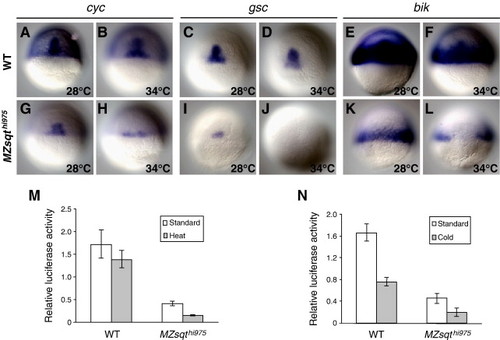Fig. 4
- ID
- ZDB-FIG-070822-37
- Publication
- Pei et al., 2007 - Environmental and genetic modifiers of squint penetrance during zebrafish embryogenesis
- Other Figures
- All Figure Page
- Back to All Figure Page
|
Temperature affects Nodal activity. (A–L) Temperature increase causes reductions in Nodal target gene expression. WT (A–F) and MZsqthi975/hi975 (G–L) embryos from single respective clutches were incubated either at 28 °C from 0 to 6 h (A, C, E, G, I, K) or 28 °C from 0–1.75 h and 34 °C from 1.75 to 5.3 h (B, D, F, H, J, L), then collected and fixed when shield formation was apparent and probed for cyc (A,B,G,H) ([Rebagliati et al., 1998a] and [Sampath et al., 1998]), goosecoid (C,D,I,J) (Stachel et al., 1993) or bhikhari (E,F,K,L) (Vogel and Gerster, 1999) expression by whole-mount in situ hybridization. (M–N) Temperature shifts cause reductions in Nodal activity. WT and MZsqthi975/hi975 embryos from single respective clutches were injected with 25 pg of luciferase reporter plasmids, incubated at 34 °C or 15 °C for 1 h starting at the 256-cell stage (2.5 hpf), or kept at 28 °C, then collected at shield stage and measured for luciferase activity. Significant reductions in activity were seen in MZsqthi975/hi975 embryos subjected to heat or cold, as well as WT embryos subjected to cold. |
| Genes: | |
|---|---|
| Fish: | |
| Condition: | |
| Anatomical Terms: | |
| Stage: | Shield |
Reprinted from Developmental Biology, 308(2), Pei, W., Williams, P.H., Clark, M.D., Stemple, D.L., and Feldman, B., Environmental and genetic modifiers of squint penetrance during zebrafish embryogenesis, 368-378, Copyright (2007) with permission from Elsevier. Full text @ Dev. Biol.

